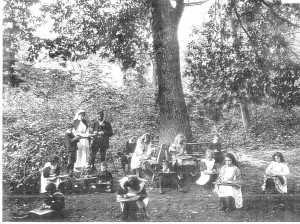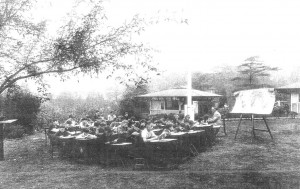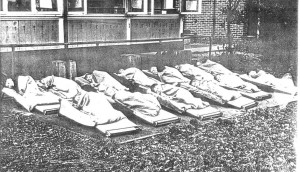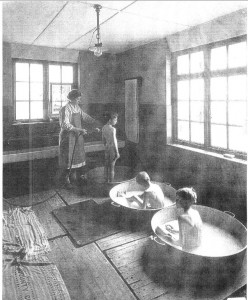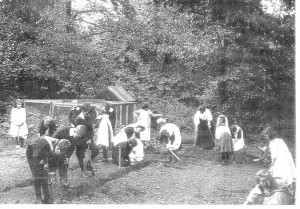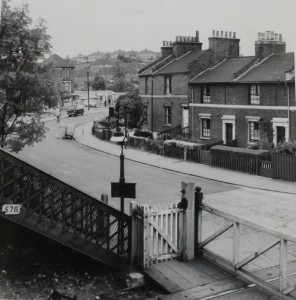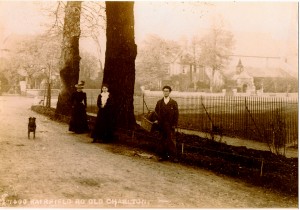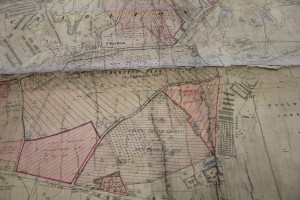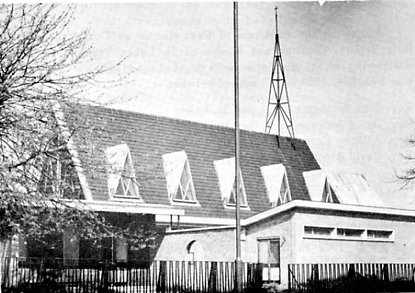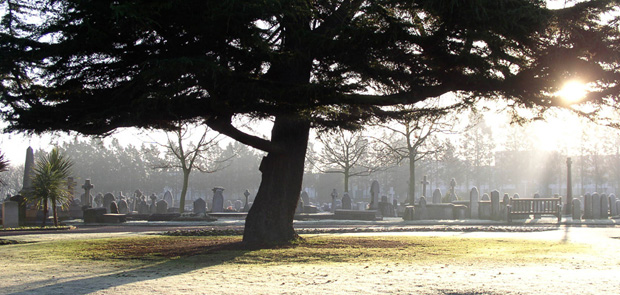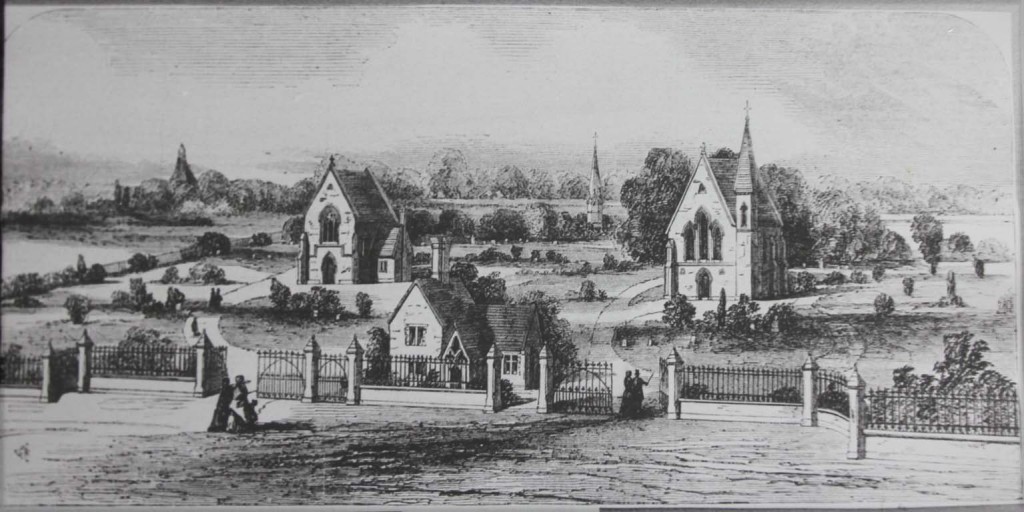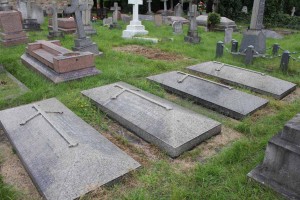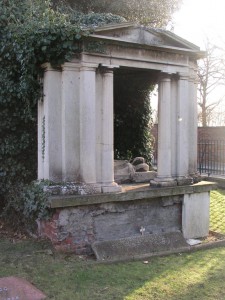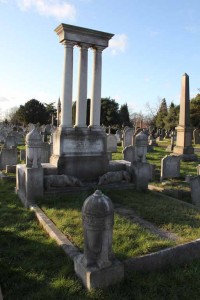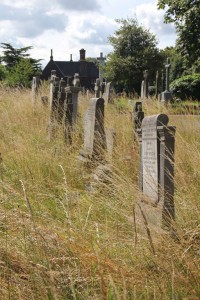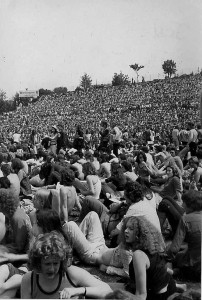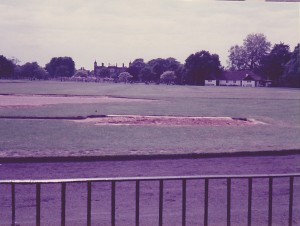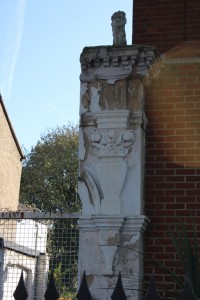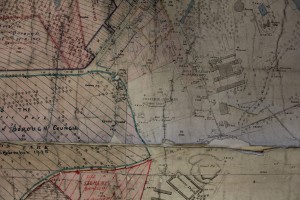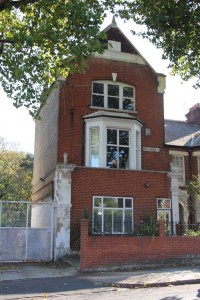[tour tab1=”Charlton Open Air School” tab2=”Pound Park” tab3=”Fairfield” tab4=”Meridian Sports ground” tab5=”Charlton Bull Pit” tab6=”Charlton Cemetery” tab7=”Charlton Athletic” tab8=”Blackheath Rugby Club” tab9=”United Dairies Farm” tab10=”Commemorating the slave trade”]
Charlton Park Open Air School
Audio Extract: George Burton remembers going to the Open Air School
Audio Extract: George Burton recalls hot days in the Open Air School
Extract from Interview Transcript: Joan Healy remembers fun and tragedy at the Open Air School
I went to Charlton Park Open Air School in Charlton and I think I was about eight years old. I’d come from a large family and we’d had T.B. and I was classed as a delicate child so I’d lost quite a lot of schooling from the ordinary school. I went to the open air school because they thought that kind of outdoor schooling would help and it obviously did because here I am as fit as anything at sixty-four.
I come from a large family of eight and they went to ordinary schools. I was number seven.
Well, we’d get there at nine o’clock in the morning, picked up by coach. I remember there was the big, main hall and we’d go in and then we’d have breakfast and then, obviously, assembly. Then it was lessons, whatever… Maths or English, and then we’d stop for dinner. We did a lot of gardening at the school. They had their own garden and we were really encouraged to be quite sporty but mainly we had the same kind of lessons that you would get in an ordinary secondary or primary school. Then just before four we had tea and also we did have a sleep in the afternoon. So I suppose, in a way, it was like a residential school but you didn’t stay. Yeah, I thoroughly enjoyed it there.
They had funny sort of canvas beds that you lie on. We hated it. There was always a chance when the teachers weren’t looking to sort of have a chin wag with each other.
I had a good friend because we were kids together in more or less in the same area, where we lived – Linda. She was a right go-getter she was. I can remember there was Christine Woodley, Joan Ellis. There was the three Britton girls. They were sisters, they had all gone there because it was not only T.B. or lung problems. There was a lot of asthmatics. Mainly it was asthmatic people. I remember there was a boy there who had polio and there was another girl who had quite an effect on me because she was quite, sort of, disabled and she used to frighten me. She was a bit sort of twisted and I was, sort of like looking back, it was quite a shame but then something happened and we became really firm friends. I used to stick up for her and then one day we were all in assembly and she’d died and I couldn’t believe it. Dorothy, she’d died. Yeah, she’d had some heart problem and she just sort of died in her sleep. That was quite an effect on me. I remember another girl called Brenda. She was absolutely devastated. I suppose… you don’t get all this counselling and all this… you know, like when things happen. Yeah, there was a few that never really made old bones, I suppose. Through the years, because I haven’t really moved out of the area, I still see some people that I went to school with and it’s how ‘did you know so-and-so? Well, she died or he died.’ But we were alright from there. There were a few children there that were from maybe more… not go through the class thing… but, you know, wouldn’t have been working-class. They would have been, maybe, middle-class. Lived in Blackheath and that but we all rubbed along.
Audio Extract: George Burton describes the cold at the Open Air School
Audio Extract: George Burton remembers the physical work at the Open Air School
Pound Park
“Land east of Charlton Lane, near the railway, was leased to the Parish by the Maryon-Wilson estate and until 1871 used for overnight enclosure of animals waiting to pass through the toll gate at the junction of Charlton Lane and Lower Woolwich Road. By 1899 it had become partly a recreation ground and partly was used for grazing by a dairy herd belonging to Mr Creed.
In July 1920 the Hospital Welfare Society held the Royal Fair on the ground, and thousands attended. In the same month, Greenwich Borough Council compulsorily purchased 42 acres of Pound Park and other land bordering Hanging Wood Lane for housing purposes. This was the beginning of municipal building in Charlton.” John Smith, The History of Charlton, 1970.
Opposite Gilbert’s Pit in Charlton is an area that was once Charlton’s first public park. Pound Field was originally used as an overnight animal enclosure but was opened as a Recreation Ground in 1889 and renamed Pound Park. From 1909 to 1918 it was the home ground for Charlton Athletic Football Club and in 1920 was the location for a special fund raising event featuring the Royal Fair. Later that year the Park was transferred to the Greenwich Borough’s housing department and became the site of Charlton’s first council homes, built as family houses with three bedrooms and gardens. Although Charlton lost Pound Park with the growing population it gained two schools. Thorntree Junior School was opened in 1927 and Pound Park Nursery was opened in 1944 both on the site of Pound Park.
Fairfield
“This was a 4 acre field to the eastern end of the Village, bordering Charlton Road and originally part of the Maryon-Wilson estate. It derived its name from the Horn Fair held annually from 1819 (when it had been banished from the Village Green) until 1871, when it was suppressed by Act of Parliament. The field was left for grazing until 1872 when Mr Charles Curtoys obtained a lease and allowed cricket matches, lawn tennis and other sports. In 1921 it was purchased from the Maryon-Wilson estates by Greenwich Borough Council for municipal housing. The turf was used by Siemens for their sports ground.” John Smith, The History of Charlton, 1970.
Meridian Sports Ground
“In 1921 17 acres of Stoneycrop (Stonefield) Farm, bordering Charlton Park Lane was leased to Messrs Siemens Bros Ltd as a sports ground for their employees. It was leveled off and turf from Fairfield was laid. The ground was used for tennis, cricket and bowls. 10 years later the freehold was purchased, but the promised new pavilion was not built, and the existing small wooden pavilion and 4 ex-army huts continued in use. In May 1939 a new 2 storey pavilion was built of brick and stone, costing £10,000. It contained a dance hall and a concert hall to seat over 500, above a 250 seater canteen. It also contained dressing rooms, showers, meeting rooms, and a balcony to watch the sports field. There was living accommodation for the steward and his family. During the 2nd World War it was used as a temporary rehabilitation centre for bombed-out families.
In 1968 the Woolwich works closed and the sports ground, which had formerly had a membership of 8000, became neglected. Attempts were made to sell it for housing, but planning applications were turned down. In 1977 it was leased Greenwich Council Sports consortium, who agreed to renovate it. A co-operative of various clubs was formed as the Meridian Sports Social Trust Ltd, and they took over the running and upkeep.” John Smith, The History of Charlton, 1970.
Charlton Bull Pit
A surprising reference to sport during medieval times in the area comes from J.A Sage in a 1927 copy of the Siemens Magazine. He refers to Bull Baiting in the Pit which was a basin shaped area in what is now Charlton Park Lane and in the 1920’s.
‘The Pit as we see it today does not present a very spectacular view. A fair sized basin-shaped excavation, measuring roughly sixty feet in diameter and thirty feet deep; covered with undergrowth and studded with numerous trees, which tend to give the appearance of a natural hollow. The presence of trees indicates that its original use died out long ago, a fact which doubtless eased many a bovine mind.”
Bull Pit Cottages still stood within the proximity of the Pit. The sport consisted of bulls being enraged until they were sufficiently maddened and then bull dogs would be given to the bull to kill for the pleasure of the crowd. J A Sage Charlton and Its Environments, Siemens Magazine January 1927.
St. Mary, Charlton in the parish of St. Luke with Holy Trinity
Designed by architect Ralph Covell, built in 1961.
“This was a daughter church of Charlton, St. Luke with Holy Trinity.
A modern design dual purpose community centre / chapel, seating 200. Built ‘with war damage money on an old bull-pit …. It must have been badly built, or the old pit not properly filled in, as within ten years it suffered badly from subsidence (as evidenced by the 1971 quinquennial report). Last in use 1974 but by then only as a youth club and community centre, not a place of worship. A reference on file has it still standing in 1975 but demolished some time therefter. Houses (St. Mary’s Court) were built on the site, which was presumably sold freehold as neither the Diocese nor the Parish seem to retain an interest in it.”
information taken from ‘Former Places of Worship in the Diocese of Southwark’ web.
The Charlton Cemetery
“The Charlton Cemetery is one of the first of those provided under the new Burial Act and contains rather more than five acres of land, pleasantly situated on the high road from Charlton to Woolwich – common. It was purchased by the Burial Board for a considerable sum, on account of its superiority and peculiar advantages as regards contiguity to the parish, fine soil, easy access &c.
The ground is laid out and planted with trees, shrubs &c., of a choice description, a portion being set apart for the use of Dissenters, and is inclosed on the front side with a dwarf plinth-wall of red brick and Portland stone in character with the rest of the architecture, and a neat iron palisading on the top. Separate entrances are provided for the Episcopal and Dissenters’ portion on the ground.
The entrance-lodge stands in front, contiguous to the gates, and is a red brick building, with stone dressings round doors and windows, and an open timber porch. It contains apartments for the porter and a general waiting-room.
The chapels, which stand on the rising ground, are seen to an advantage from the public road……..Both chapels are built of Kentish rag-stone, and Bath-stone dressings to the doors, windows and other parts.” London Illustrated News, 1857.
Amongst the memorials are numerous monuments to the army and the navy and personnel connected with the Royal Artillery at Woolwich. Sir John Maryon – Wilson his wife Charlotte Julia Wade and daughters Jane Charlotte Wilson and Caroline Maria Wilson are buried in one vault, while his son Frederick Maryon-Wilson and his wife Mary Angelina Wilson and their son Norman Maryon-Wilson are together in an adjacent vault. Two nearby vaults of the Perceval family lie alongside those of the Maryon-Wilson families.
An urn on a plinth commemorates the death of 52 men and boys who died of yellow fever on the HMS Firebrand in 1861.
Near the entrance is the memorial to Jemima Ayley who died in 1860 on the eve of her wedding. below the canopy is a vault containing the table and chair used by mourning relatives.
Mal Gallaghy walks in Charlton Cemetery
An elaborate tomb to Thomas Murphy who died in 1932, owner of the Charlton greyhound track is found further in the cemetery.
Today the cemetery boasts a Cemeteries Conservation grass area put in place in 2011 in line with the Borough’s Biodiversity plan.
Charlton Athletic Football Club, The Addicks
On June 9, 1905, a number of youth clubs in the south-east London area, including both East Street Mission and Blundell Mission, combined to form Charlton Athletic Football Club.
The club’s first ground was Siemens Meadow (1905–1907), a patch of rough ground by the River Thames. This was over-shadowed by the now demolished Siemens Telegraph Works. Then followed Woolwich Common (1907–1908), Pound Park (1908–1913), and Angerstein Lane (1913–1915).
After the end of the First World War, a chalk quarry known as The Swamps was identified as Charlton’s new ground, and in the summer of 1919 work began to create the level playing area and remove debris from the site. The first match at this site, now known as the club’s current ground The Valley, was played in September 1919. Charlton stayed at The Valley until 1923, when the club moved to The Mount stadium in Catford as part of a proposed merger with Catford Southend Football Club. However, after this move collapsed in 1924 Charlton returned to The Valley.
Blackheath Rugby Club
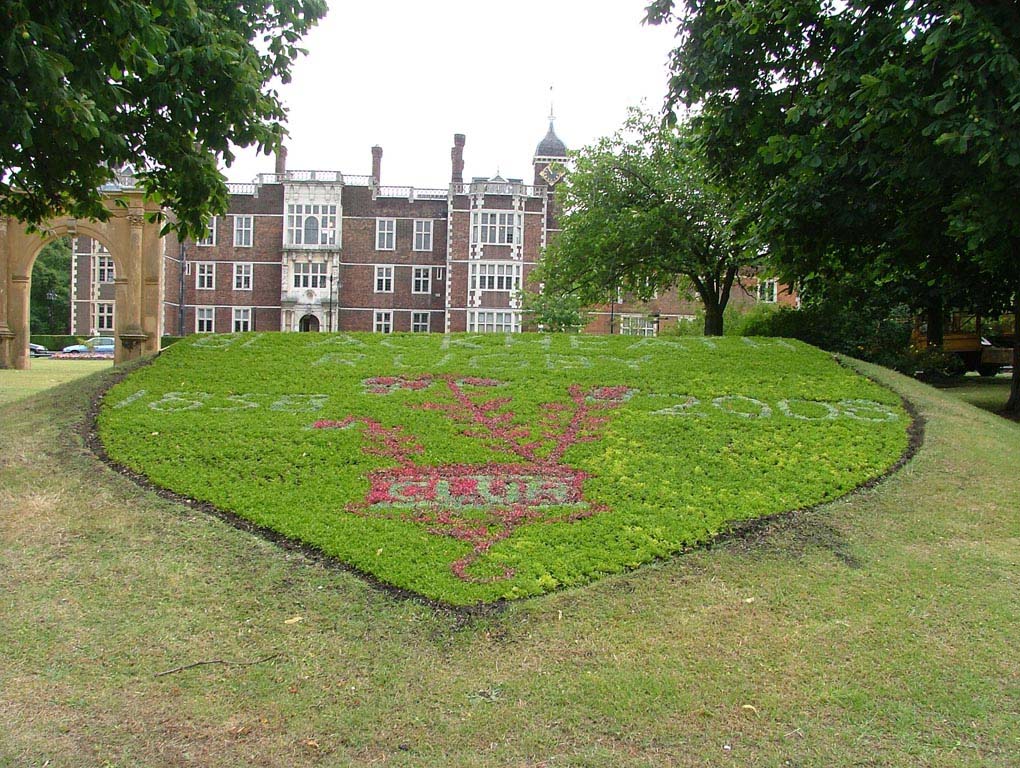
Blackheath Rugby Club 150 year celebratory floral shield, Charlton House. contributed by Blackheath Rugby Club
The Maryon Wilson family owned Charlton House and the park and also owned the Rectory Field until 1922 when it was bought by the Blackheath Cricket, Football and Lawn Tennis Company that still runs the sports club. The field was leased to St Luke’s Church, Charlton from 1832 until 1885 when the company took it over.
1914-1918 the military based in Charlton Park used the Rectory Field for training, sport and washing. Possibly the Royal Field Artillery, 5C Reserve Brigade and 6B Reserve Brigade 18th July 1918 but this does need further research. (Editor’s Note: We know from photographs held in the Royal Artillery Library that the Brigade using the Park in 1915 was the 17th Heavy Battery Royal Garrison Artillery.)
1970s Club used the park for pre-season training sometimes. They used the Park for pre-season training.
1980s the park was used by members of Blackheath rugby, cricket and tennis members to play mixed hockey on the ground behind Charlton house. The Club uses the park to play mixed hockey on the ground behind Charlton house,captained by a woman, cricket and tennis.They were quite successful as the captain enforced a rule which made the men pass to the women thus ensuring that they played as a team. The captain also instituted team hugs which she felt build up the team spirit and feelings of equality.
Around 1995 (we’re trying to pinpoint exactly when) the changing rooms were repaired and the mini and junior rugby sections used the park on Sunday mornings and the Club used two pitches for the men’s teams on Saturday.
At some point a rugby Club dinner was held in Charlton House possibly 1997.
2000-2001 The floodlight were repaired and the ground within the running track used for training on Mondays and Thursdays.
2001-2002 The club worked with the Greenwich Council to raise funds to have the old running track grassed over and floodlit for rugby training in the early 2000s. The training ground was enlarged by removing the running track.
2007-2008 season the Club ceased to play at the park and moved to Well Hall.
2008-2009 As acknowledgement of this partnership, the flowerbeds in front of Charlton House depicted the clubs logo on occasion of their 150th anniversary. In the recent past, the Club held their annual dinner at Charlton House. Notes by Mandy & Peter
A recollection:
Mrs. Wood (89). Her father and three generations of male forebears previously were groundsmen for Blackheath Rugby Club. The family lived adjacent to the Rectory Fields. In answer to a questions as to which parks in Charlton she may have used as a child, Mrs. Wood said her father in answer to a request to go to Charlton Park: ‘if this (Rectory Fields) isn’t big enough she should stay in doors’. As a result she did not play in any of the Charlton parks as her playground was the Rectory Fields.
Park Farm – United Dairies
The first record we can find of a farm near Little Heath is 74 Littleheath, Charlton, found in Kelly’s Directory for 1912. At the time owned by James Buckingham, cowkeeper and dairyman.
76 Littleheath appears to be the entrance to the farm and the remnants of an arched entrance way can still be seen attached to 74 Littleheath.
By 1923, 74 Littleheath is recorded as occupied by Edward’s & Sons, dairy farmers. Edwards is also recorded as owning Park Farm, Cemetery Lane and 16 Pellipar Road, Woolwich. The entry name is in bold, indication an owner of some wealth.
At the same time Thomas William Baines is recorded as occupying Park Farm Cottage, Cemetery Lane possibly a tenant of Edwards.
In 1955 there is no entry for the United dairies in the Woolwich Civic & Commercial Directory for cemetery Lane, but many local people recall the United Dairies depot to the north of Charlton Cemetery. Some people recall animals there in the mid 1950’s, but whether horses that drew the milk floats or cattle no-one can say exactly.
However the sale of Park Farm to United Dairies on 29.11.1930 is recorded on a map of the Maryon-Wilson estate held by London Metropolitan Archives. (Editor)
74 Littleheath appears to have been the dairy shop.
At some time in the 1970’s or 1980’s the original shop front was removed and the shop converted to a private residence. I recall the shop in the mid ’70’s as selling antiques. Entrance was gained through a recessed doorway on the left hand side, while the rest of the frontage was a large plate glass window. I believe the floor to the entrance way was tiled in black & white square tiles.
Extract from Interview Transcript: Mavis and Fabian Best talk about commemorating the slave trade
So tell me about the tree planting.
MAVIS: 2007. The government wanted to recognise the slave trade and the impact on this country and we got engaged with some people who were campaigning but not being involved with the campaign and we were invited to a meeting to discuss appreciation of our sadness of what had actually happened and it was called, ‘Set Us Free.’ And the Queen was there, Prince Philip and the relative of Wilberforce was also there and the Archbishop of York came and spoke. It was very good to have that to mark it but it was nothing specific and there were some people saying that there should be an apology to the Caribbean community for slavery, because there was an apology for the Maoris and the other people like the Jews and so on and all that we needed was to acknowledge that it had happened.
And there was a commotion outside and, you know, we thought, ‘Goodness!’, you know and the police was called and so on. This guy shouted out that, you know, ‘No apology, no good!’ sort of thing and we thought that wasn’t the place for it. But we came outside and I thought, ‘Well, we have to do something in the African Caribbean community to at least recognise it since the government recognise it but not in the way in which we expected it to happen.’ And I spoke to Baroness Howells, and Fabian, my husband, and Baroness Howells – she lived in the borough – and a few other people from a Caribbean background who sit in the House of Lords. ‘The least we can do, you know, is to plant a tree,’ I said to Fabian and Baroness Howells.
So I then thought we would plant a tree but we hadn’t thought about the Peace Garden then. It was only after we got back we discussed it and I said, “Charlton Park would be the best place. The Peace Garden would be a good place to do it.” And then, because we’re on the committee at Charlton House we took it to the committee and it was agreed that we could plant a tree.
FABIAN: It was discussed locally and it was discussed with the African Caribbean community in Woolwich, in Greenwich, so those were the sort of connections to help to formulate the idea and get it to some point where you can then put it to the Friends of Charlton House and that’s because it’s not one or two people thinking about it. It’s a wider group.
Yeah, I understand.
MAVIS: The one group that we spoke to who supported it… that was an organisation called the Greenwich African Caribbean Women’s Organisation but it was a young sort of group not long off the ground and mainly women and a few other people at an organisation called Simba. We spoke to them and they said, “That’s a good idea,” but that’s all, that’s as far as it got with them. They didn’t know how they could do it but we thought: Charlton House. We made a proposal to the committee and they accepted that we could do that.
But it was very, very difficult indeed. It become politicised when it should not have been.
They didn’t feel it was the wrong. They just said that they should have more say in it in terms of how it should be done. It’s an emotional issue for Caribbean people. They just felt a bit suspicious that it should be done without them having full rein over it and it was Fabian and myself and the members of Charlton House committee so we were caught between two stools really.
Were you both pleased at the way it eventually turned out?
MAVIS: Yes. Yes, we were very pleased actually.
FABIAN: Yes.
MAVIS: I think I was… both sides. We wanted too to put a bench near the tree but we didn’t manage to get that through and we still have some money to give back, part of the money gained from the community.
These things are not very easily… easily done.
Clearly not.
[/tour]

